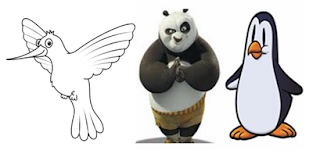 |
| Google's Zoo: Hummingbird, Panda & Penguine |
The common way of thinking for a decade or longer was the more keywords you could work into a page, the better your rankings would be. Early on in the life of Google, that was pretty much true. But, since the release of all the animals in the Google zoo (Panda, Penguin and Hummingbird), SEO copywriting has made a 180-degree shift.
How Did We Get Here?
It’s no accident that website owners and copywriters were taught to incorporate keyphrases into their text frequently. Search engines are text machines. They can’t see pictures or listen to podcasts. In effect, search engines are deaf and blind. The only thing that guides them is text, and that includes the words in file names, page names, image tags, meta tags and page copy.
Because of the level of technology Google had in the early days, it depended on exact-matching of the words in a search query to the words on and behind the page (in the HTML code, for example).
A Panda on the Loose:
Several years ago, however, Google began to make significant changes with the Panda update. In the name of quality, the Big G began to police things like trust elements, duplicate content, originality and value. Article directories and ecommerce sites that used manufacturer-provided content took huge hits, while others scrambled to make sure their content met Google’s new standards.
Penguin Freezes Out Over-Optimization:
Around a year later, Google unleashed the Penguin update. Unnatural linking practices and the over-optimization of web pages were added to the list of things which website owners needed to be wary. That frequently meant reducing the number of times a keyphrase was used and increasing the use of synonyms.
The Hummingbird Algorithm Takes Flight:
Most recently, Google announced their entirely new ranking algorithm called Hummingbird, which had actually been running for approximately one month without the general population knowing it. One of the major highlights of Hummingbird revolves around spoken searches and conversational searches.
Essentially, Hummingbird is better at recognizing and understanding how spoken search queries and typed search queries could mean the same things. (Again… synonyms.)
When you combine the impact of all three updates, you begin to see that Google is no longer interested in blindly matching keyword for keyword. Rather, they want to understand better what the searcher is trying to achieve, so they can deliver the most accurate results.
What You Should Do Now
Whether you’re just starting to write copy for your website, or your existing text is several years old, here are my suggestions:
Need to STOP...
- Shoving keywords into every place possible.
- Trying so hard to optimize the page. (Google doesn’t need that much help anymore.)
- Focusing on formulas and densities.
- Optimizing for one or two keyphrases.
Need to START...
- Using exact-match keyphrases sparingly.
- Using individual keywords.
- Writing naturally with a sprinkling of keywords.
- Placing keyphrases and keywords where they make sense, not where you think the search engine wants them to go.
- Incorporating synonyms in addition to your chosen keyphrases.
By making some simple adjustments to your copy, you could quickly get up to date with Google’s three-year campaign to improve search quality. Providing better copy and content for your visitors will give you a win-win with search rankings, too.
Author: Karon Thackston from sitepronews






0 comments:
Post a Comment